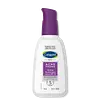Dermal Therapy Acne Control Lotion Versus Cetaphil Pro Acne Prone Oil-Free Moisturising Lotion SPF 25
What's inside
What's inside
 Key Ingredients
Key Ingredients

 Benefits
Benefits

 Concerns
Concerns

 Ingredients Side-by-side
Ingredients Side-by-side

Water
Skin ConditioningSodium Hydroxide
BufferingPEG-100 Stearate
Glycerin
HumectantCetyl Alcohol
EmollientPotassium Cetyl Phosphate
EmulsifyingSodium PCA
HumectantZinc PCA
HumectantCarbomer
Emulsion StabilisingPropanediol
SolventPotassium Azeloyl Diglycinate
Skin ConditioningBakuchiol
AntimicrobialNiacinamide
SmoothingPolylysine
Sodium Hyaluronate
HumectantHydrolyzed Algin
Aloe Barbadensis Leaf Juice Powder
Skin ConditioningMaclura Cochinchinensis Leaf Prenylflavonoids
Zinc Sulfate
AntimicrobialMaltodextrin
AbsorbentGlyceryl Caprylate
EmollientCitric Acid
BufferingDehydroacetic Acid
PreservativePhenoxyethanol
PreservativeBenzyl Alcohol
PerfumingWater, Sodium Hydroxide, PEG-100 Stearate, Glycerin, Cetyl Alcohol, Potassium Cetyl Phosphate, Sodium PCA, Zinc PCA, Carbomer, Propanediol, Potassium Azeloyl Diglycinate, Bakuchiol, Niacinamide, Polylysine, Sodium Hyaluronate, Hydrolyzed Algin, Aloe Barbadensis Leaf Juice Powder, Maclura Cochinchinensis Leaf Prenylflavonoids, Zinc Sulfate, Maltodextrin, Glyceryl Caprylate, Citric Acid, Dehydroacetic Acid, Phenoxyethanol, Benzyl Alcohol
Water
Skin ConditioningOctocrylene
UV AbsorberIsopropyl Lauroyl Sarcosinate
Skin ConditioningEthylhexyl Salicylate
UV AbsorberGlycerin
HumectantDimethicone
EmollientButyl Methoxydibenzoylmethane
UV AbsorberDiisopropyl Sebacate
EmollientSucrose Tristearate
EmollientAluminum Starch Octenylsuccinate
AbsorbentSilica
AbrasivePolymethyl Methacrylate
Polysorbate 61
EmulsifyingPentylene Glycol
Skin ConditioningAllantoin
Skin ConditioningCaprylyl Glycol
EmollientCarbomer
Emulsion StabilisingDimethiconol
EmollientDisodium EDTA
Glycyrrhetinic Acid
Skin ConditioningHydroxypalmitoyl Sphinganine
Skin ConditioningPanthenol
Skin ConditioningPhenoxyethanol
PreservativePotassium Sorbate
PreservativeSodium Stearoyl Glutamate
CleansingTocopheryl Acetate
AntioxidantTriethanolamine
BufferingXanthan Gum
EmulsifyingZinc Gluconate
Skin ConditioningWater, Octocrylene, Isopropyl Lauroyl Sarcosinate, Ethylhexyl Salicylate, Glycerin, Dimethicone, Butyl Methoxydibenzoylmethane, Diisopropyl Sebacate, Sucrose Tristearate, Aluminum Starch Octenylsuccinate, Silica, Polymethyl Methacrylate, Polysorbate 61, Pentylene Glycol, Allantoin, Caprylyl Glycol, Carbomer, Dimethiconol, Disodium EDTA, Glycyrrhetinic Acid, Hydroxypalmitoyl Sphinganine, Panthenol, Phenoxyethanol, Potassium Sorbate, Sodium Stearoyl Glutamate, Tocopheryl Acetate, Triethanolamine, Xanthan Gum, Zinc Gluconate
Ingredients Explained
These ingredients are found in both products.
Ingredients higher up in an ingredient list are typically present in a larger amount.
Carbomer is a polymer of acrylic acid. Its main role is to create a gel consistency.
A high amount of carbomer can cause pilling or balling up of products. Don't worry, most products contain 1% or less of carbomer.
Glycerin is already naturally found in your skin. It helps moisturize and protect your skin.
A study from 2016 found glycerin to be more effective as a humectant than AHAs and hyaluronic acid.
As a humectant, it helps the skin stay hydrated by pulling moisture to your skin. The low molecular weight of glycerin allows it to pull moisture into the deeper layers of your skin.
Hydrated skin improves your skin barrier; Your skin barrier helps protect against irritants and bacteria.
Glycerin has also been found to have antimicrobial and antiviral properties. Due to these properties, glycerin is often used in wound and burn treatments.
In cosmetics, glycerin is usually derived from plants such as soybean or palm. However, it can also be sourced from animals, such as tallow or animal fat.
This ingredient is organic, colorless, odorless, and non-toxic.
Glycerin is the name for this ingredient in American English. British English uses Glycerol/Glycerine.
Learn more about GlycerinPhenoxyethanol is a preservative that has germicide, antimicrobial, and aromatic properties. Studies show that phenoxyethanol can prevent microbial growth. By itself, it has a scent that is similar to that of a rose.
It's often used in formulations along with Caprylyl Glycol to preserve the shelf life of products.
Water. It's the most common cosmetic ingredient of all. You'll usually see it at the top of ingredient lists, meaning that it makes up the largest part of the product.
So why is it so popular? Water most often acts as a solvent - this means that it helps dissolve other ingredients into the formulation.
You'll also recognize water as that liquid we all need to stay alive. If you see this, drink a glass of water. Stay hydrated!
Learn more about Water